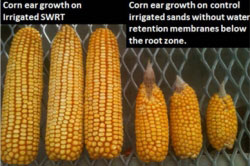Revolutionary technology aids thirsty crops during drought
While much of the nation's crops withered under the punishing drought of 2012, MSU researchers dramatically increased corn and vegetable production on test farms using revolutionary new water-saving membranes.
 While much of the nation’s crops withered under the punishing drought of 2012, Michigan State University researchers dramatically increased corn and vegetable production on test farms using revolutionary new water-saving membranes.
While much of the nation’s crops withered under the punishing drought of 2012, Michigan State University researchers dramatically increased corn and vegetable production on test farms using revolutionary new water-saving membranes.
The subsurface water retention technology process was developed by Alvin Smucker, MSU professor of soil biophysics and MSU AgBioResearch scientist. His invention uses contoured, engineered films, strategically placed at various depths below a plant’s root zone to retain soil water. Proper spacing also permits internal drainage during excess rainfall and provides space for root growth.
“This technology has the potential to change lives and regional landscapes domestically and internationally where highly permeable, sandy soils have prohibited the sustainable production of food,” Smucker said. “Water retention membranes reduce quantities of supplemental irrigation, protect potable groundwater supplies, and enable more efficient use and control of fertilizers and pesticides.”
The prototype can be used on a broad range of agricultural crops, as well as growing cellulosic biomass feedstock, plants grown specifically for fuel production, on marginal lands. SWRT-improved irrigated sands produced 145 percent more cucumbers than did the control fields without water-saving membranes. Researchers also dramatically improved irrigated corn production, increasing yields 174 percent.
Smucker and Kurt Thelen, plant, soil and microbial sciences professor, together with Mathieu Ngouajio and Ron Goldy, horticulturalists, will lead teams of scientists, engineers and industrial agricultural experts in implementing the new technology on farms in irrigated sandy regions of southwestern Michigan and the semi-arid and arid regions of the southwestern and the midwestern U.S. Thelen and Ngouajio are also MSU AgBioResearch scientists.
Internationally, additional MSU researchers are exploring opportunities to overcome hunger with SWRT water-saving membranes in several global locations.
Smucker’s work in developing SWRT and conducting field testing was funded in part by the Michigan Initiative for Innovation and Entrepreneurship. There is a patent pending, and Smucker is working with MSU Technologies to develop the membranes on a commercial scale.



 Print
Print Email
Email




